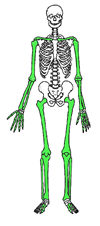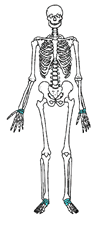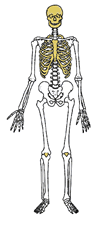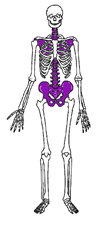Support and movement systems: Skeletons
Functions
Whether an animal's skeleton is external (as is the case for insects and
crustaceans) or internal (all vertebrates), the skeleton serves the following
functions:
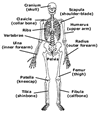
- Protection of internal organs.
- Provides support and determines shape.
- Provides a framework for attachment of muscles allowing movement.
- Some animal skeletons also produce blood cells.
The human skeleton
The human skeletal system is made up of two major 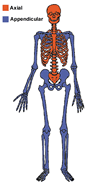 parts,
the axial and the appendicular.
parts,
the axial and the appendicular.
- The axial skeleton consists of the skull, the vertebrae (backbone)
and the ribs. Their main function is to protect the vital organs of
the body, namely, the brain, the spinal cord and the heart and lungs.
These bones provide some of the structure of the body.
- The appendicular skeleton includes all the other bones that are attached
to the axial skeleton, such as the arms and legs. Their main function
is to allow movement.
Types of bones
The main types of bones are:
- Long bones, found in the arms, legs, fingers and toes, allow movement.
- Short bones, found in the ankles and wrists, provide strength and
flexibility, and absorb impacts.
- Flat bones, found in the ribs and the skull, protect vital organs.
- Irregular bones have no particular shape. Any of the bones that do
not fit into the other categories are included here. A very important
irregular bone are the vertebrae that link together to form the backbone.
|
Long bones
|
Short bones
|
Flat bones
|
Irregular bones
|
- Compact bone provides the outside coating of all bones, except on
the ends of long bones. It gives the strength to withstand bumps and
scrapes.
- Spongy bone is found on the inside of both flat and short bones and the ends of long bones. It acts as a shock absorber. Red blood cells are made in the red bone marrow of spongy bone in the long bones. The yellow marrow in the shaft of long bones is a fat-storage area.
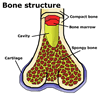 Calcium is used by the body to strengthen bone, and as such, it is
essential in the diet.
Calcium is used by the body to strengthen bone, and as such, it is
essential in the diet.
Skeletal connections
Joints allow for movement between bones. The main types are:
- Ball and socket joints, found in the shoulder and the hip, allow
360 degree movement of the arms and legs.
- Hinge joints allow movement in one direction only, e.g. knee, elbow.
- The pivotal joints of the neck allow movement up and down and side
to side.
- Other joints allow little movement, for example, the gliding joint of the wrist and ankle, or no movement, e.g. the fixed joints of the skull which, once fused in childhood, don't move at all.
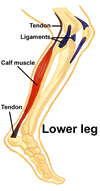

|
Joints |
Ligaments, tendons and cartilage
- Ligaments hold bones together at joints.
- Tendons attach muscles to bones.
- Cartilage is found between bones that have a large amount of movement. It prevents them rubbing together and grinding away, such as at the knee and between vertebrae.
| Copyright owned by the State of Victoria (Department of Education and Early Childhood Development). Used with Permission. |
